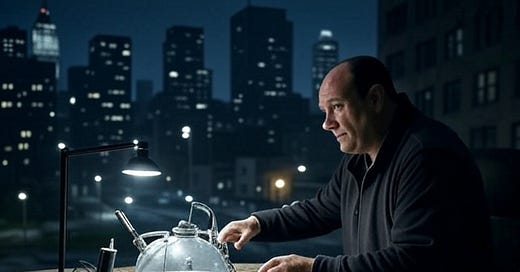Two of the greatest television series ever made, *The Sopranos* and *The Wire*, have left an indelible mark on storytelling, offering unflinching portraits of crime, power, and human nature. I binged *The Sopranos* during the pandemic, savoring every episode, and now I’m slowly working my way through *The Wire*, a dense, rewarding journey. Both shows are masterpieces—long, demanding, but worth every moment, like anything truly valuable in life.
What makes these series fascinating is their shared focus on the drug trade, or what could be called "narco-economy." They tackle it from different angles—*The Sopranos* through the lens of organized crime and personal ambition, *The Wire* through systemic failure and societal decay—but both reveal drugs as a shadowy force driving crime, corruption, and despair. In *The Wire*, drugs are the hidden killer, the root of everything from street violence to political rot. Remove drugs from the equation, and the story collapses. Crime would persist, sure, but the drug war—the endless cycle of arrests, turf battles, and broken lives—wouldn’t exist.
A Force of Nature
One scene in *The Wire* crystallizes this idea. A retiring police chief, grappling with an existential crisis, questions his legacy. Decades of work, sacrifice, and death, and Baltimore’s streets remain unchanged. A local reverend, trying to console him, offers a profound insight: drugs are like the wind or the rain—a force of nature. They exist because humans do. As long as humanity endures, so will drugs. This moment lays bare the absurdity of the war on drugs. It’s a battle against human nature itself, a conflict without end.
The logical conclusion, hammered home episode after episode, is that legalizing drugs might be the only way to break the cycle. Legalization could dismantle the black market, reduce violence, and redirect resources to treatment and education. But let’s be real: society, politicians, and the public aren’t ready to accept this. Cultural stigmas, moral panic, and entrenched interests make it a non-starter. So, if legalization is off the table, what’s left? Technology might hold the answer.
The Technological Promise
Recent advances in artificial intelligence, biotechnology, and advanced manufacturing are opening doors to a future where the drug trade could be disrupted—not through policy, but through innovation. Imagine a world where drugs, or their medicinal equivalents, could be produced at home, safely and legally, using cutting-edge tools. This wouldn’t just undermine criminal networks; it would give individuals unprecedented freedom, tempered by the responsibility to use it wisely.
AI and Drug Design
Artificial intelligence is already transforming the pharmaceutical industry. Tools like AlphaFold3, developed by Google DeepMind, can predict how proteins, DNA, and molecules interact with astonishing accuracy. This speeds up drug discovery, potentially making it easier to design compounds that mimic the effects of illegal drugs but are safer and legal. For example, AI could help engineer bacteria or yeast to produce therapeutic molecules, reducing reliance on complex supply chains. While AlphaFold3 is currently a research tool, its descendants could democratize drug development, bringing it closer to the hands of individuals.
3D Printing and Personalized Medicine
3D printing is another game-changer. The FDA-approved drug Spritam, used to treat seizures, is made with 3D printing, allowing precise dosing and rapid disintegration for patients who struggle to swallow pills. While this technology is confined to pharmacies and hospitals, the dream is to scale it down for home use. Imagine a 3D printer loaded with pharmaceutical-grade ingredients, churning out custom medications—or even recreational compounds—on demand. The catch? You’d need access to active pharmaceutical ingredients (APIs), which are tightly regulated, and the know-how to ensure safety.
Bioreactors and DIY Biology
Biotechnology is pushing boundaries with bioreactors—devices that cultivate cells or microbes to produce compounds. The Farma project, a speculative DIY initiative, envisions home bioreactors growing modified Spirulina to churn out drugs like opiates or antimalarials. Meanwhile, the Open Insulin Project is developing open-source protocols to produce insulin using engineered *E. coli*, aiming for community-based production. In Finland, the CellPod prototype grows plant cells for cosmetics and supplements, hinting at what’s possible. These are early steps, but they point to a future where bioreactors could sit in homes, like high-tech bread machines, producing everything from painkillers to antidepressants.
Flow Chemistry and Microfluidics
Flow chemistry, which runs reactions through compact, continuous systems, offers a safer, more efficient way to synthesize chemicals. Combined with 3D-printed reactors, it could make small-scale drug production feasible. Microfluidics, used to create precise drug-delivery systems like nanoparticles, is another frontier. But both technologies are stuck in labs, requiring specialized equipment and expertise. Home use is a distant goal, with risks like handling hazardous chemicals or botching reactions looming large.
The Challenges Ahead
The vision of home-grown drugs is tantalizing, but it’s not around the corner. Safety is the biggest hurdle. Producing insulin or other critical drugs at home demands rigorous quality control—mistakes could be deadly. Even recreational drugs need to be pure and properly dosed to avoid harm. Regulatory barriers are another issue. APIs are controlled substances, and governments aren’t likely to let them flow freely. Plus, the tech—whether bioreactors or flow systems—requires skills and resources beyond the average person’s reach.
Then there’s the ethical question: even if we could produce drugs at home, should we? Freedom to choose comes with the risk of misuse, addiction, or unintended consequences. The reverend in *The Wire* was right—drugs are part of human nature, but so is our capacity for self-destruction. Any technological solution must balance liberty with responsibility.
A Future Worth Imagining
Despite the challenges, the trajectory is clear. AI, 3D printing, bioreactors, and flow chemistry are converging toward a world where drug production could be decentralized, bypassing cartels and corporations alike. Projects like Open Insulin show what’s possible when communities take control, while speculative efforts like Farma spark the imagination. In a decade or two, we might see simplified, user-friendly systems that let people produce safe, legal compounds at home, much like brewing craft beer or baking sourdough.
This wouldn’t be legalization in the traditional sense, but it could achieve the same effect: dismantling the narco-economy by making it obsolete. Crime would persist—human nature again—but the drug trade’s stranglehold would loosen. As the reverend said, nature always wins. Technology might just help us channel that force for good, giving us the tools to choose our path with eyes wide open.
In the end, *The Sopranos* and *The Wire* remind us that the drug war is a human tragedy, not a winnable fight. But where policy has failed, technology offers hope—not a perfect fix, but a step toward a world where freedom and responsibility go hand in hand.











Share this post